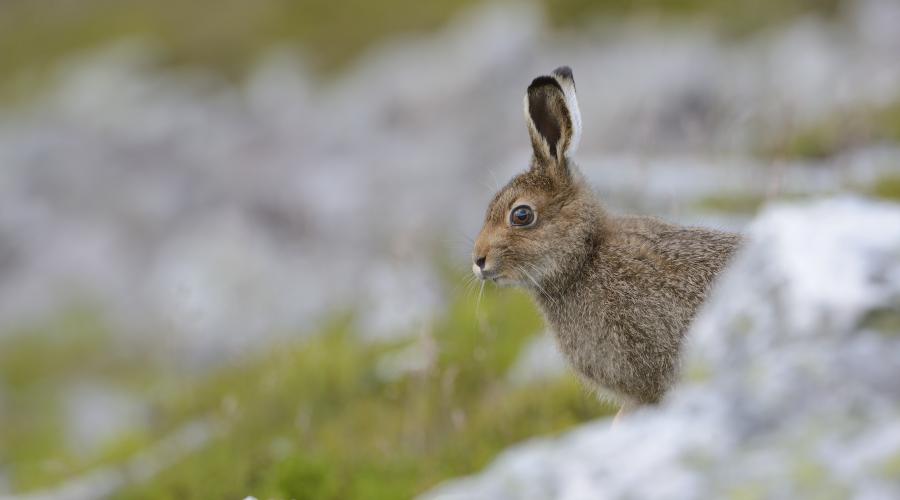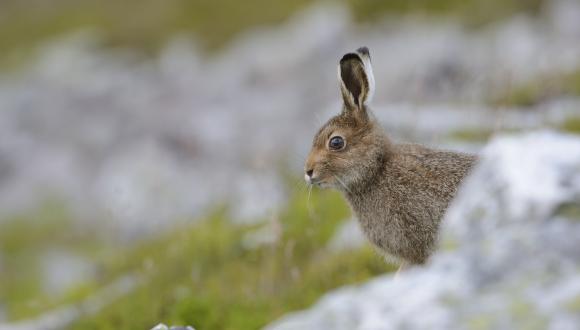
Hares and rabbits
Both the rabbit and brown hare were introduced to Britain. Scotland's native mountain hare, found on high ground, has a white winter coat to match the snow.
Rabbits and hares are herbivorous mammals of the order Lagomorpha. Britain’s only native member of the group is the mountain hare (Lepus timidus). Both the rabbit and the brown hare were introduced.
In Britain, hares are mostly animals of open ground, relying on their good eyesight, camouflage and high speed to avoid predators. They are larger than rabbits and have longer legs, and don’t live as colonies in vast burrow systems. Hares instead create ‘forms’, individual shallow scrapes in vegetation or earth.
Mountain hare
The hardy mountain hare is our only truly montane/arctic mammal and is mainly restricted to Scotland’s high ground (generally above 300 to 400m) but may also occur at low altitudes, e.g. in the north-west, where moorland can be found just above sea-level. Grey-brown in summer to blend with the heath, the mountain hare’s coat turns white in winter, to match the snow.
Heather moorland that’s actively managed for grouse provides an optimum habitat for mountain hares. Muirburn helps to ensure that young heather growth is always available. For cover, hares often use patches of woodland, including conifer plantations, next to moors.
Rotational burning plus predator control as part of heather moorland management benefits both mountain hares and red grouse. With this combination, hare densities can reach 30 to 70 individuals per sq km – and exceptionally 200 or more individuals per sq km. (Typical densities elsewhere are much lower, generally 2 to 5 individuals per sq km.) Hare numbers go up and down – by ten-fold or more – on a cyclical basis, peaking about every nine years or so.
Mountain hares were traditionally classed as a quarry species and have long been shot for sport, but they are now fully protected in Scotland. They can, however, still be legitimately controlled (under licence) for certain limited purposes including to protect young trees.
Brown hare
Russet brown, with very large ears and a black-and-white tail, the brown hare is often found in arable areas, but also occurs on grassland e.g. on the island of Tiree. This species prefers farms with mixed crops, as it needs some permanent cover. Or it may take cover in nearby hedgerows, strips of woodland or set aside.
Brown hares declined in number during much of 20th century, mainly due to changes in farming practice. The current trend is less clear but the population appears to have stabilised.
Rabbit
Rabbits are important prey for larger birds of prey and mammals such as the stoat and wildcat. And though they may cause damage, rabbits can also help to maintain some grassland habitats by providing open patches for small plants. The rabbit has many natural predators but its numbers are controlled mainly by disease.
Threats to mountain hares
Mountain hare numbers decline where heather has been removed by over-grazing by other herbivores, by conversion to forestry or (prior to legal protection) by over-exploitation in some areas.
Young forestry plantations can support high densities of hares, but numbers decline when the forest canopy closes and the ground vegetation diminishes.
On some western Scottish moors, mountain hares are now rare or absent.
Climate change may, in the future, enable the brown hare to occupy higher ground, putting the mountain hare under pressure in its natural range.
Problems caused by hares and rabbits
Like deer, the mountain hare, brown hare and rabbit are important browsing species whose activities can significantly alter vegetation structure and composition.
All three species can occur at high enough densities to cause ecological and economic damage, e.g. by browsing young trees and preventing regrowth.
Protection of hares and rabbits
Find out about hares as protected species.
Read about hares and licensing.
Read our guidance for planners and developers on protected animals
Report a sighting
Find out how to submit records of mammal sightings on The Mammal Society website.




